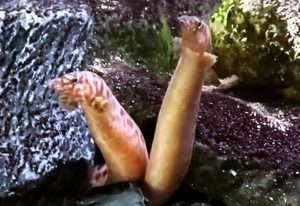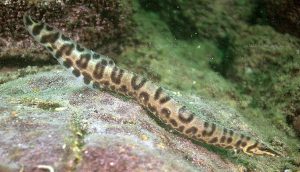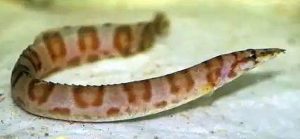The Tanganyikan Spiny Eel (Mastacembelus ellipsifer) is a nocturnal benthopelagic predator endemic to Lake Tanganyika in Africa. Also collected in Burundi, Democratic Republic of the Congo, Tanzania, and Zambia Mastacembelus ellipsifer are only one of the fifteen spiny eel species found in the Tanganyikan basin.
Tanganyikan Spiny Eels are found in the intermediate zones around the shores of Lake Tanganyika where the rocks diverge into sandier substrates. They prefer coastal waters with a sandy, rock, or a muddy bottom where most of their daylight hours are spent either buried in the substrate with only their snouts visible, or hidden among rocks where they emerge at dusk to forage on small fish, worms, and crustaceans.
Tanganyikan Spiny Eels are named such because of their very hard dorsal fin rays and because they are primarily bottom dwellers, they have no swim bladder.
The Tanganyikan Spiny Eel has an extremely elongated, laterally compressed body with a long distinctively pointed snout and an under-slung mouth. They have a brownish to beige body color with a dark brown ring shaped pattern on the back. Males are indistinguishable from females.
Because of their size, Tanganyikan Spiny Eels should be housed in at least a 55 gallon aquarium with a deep sandy or extremely fine gravel substrate and several piles of rocks arranged to form crevices, caves, and overhangs for them to hide among. A long, wide tank is preferred to a high tank. Aquatic plants are not necessary for this species and because the sharp edges on gravel can damage the eel’s skin, its use is not recommended as a substrate.
Because of its hard, alkaline water requirements, Tanganyikan Spiny Eels are not suitable for most freshwater aquariums. They are best housed in a Tanganyikan community tank, combined with species too large to be considered food. Because they tend to be territorial with conspecifics, a large tank of at least 100 gallon capacity is recommended if more than one is going to be housed.
Mastacembelus ellipsifer does not like strong current in their aquarium. Because of their nocturnal nature and burying habits, dim lighting is recommended if you want to watch your eel on a regular basis. A tightly fitting tank cover is also recommended for this species.
Although they are egg depositors, Mastacembelus ellipsifer has not yet been successfully bred in an aquarium environment.
In their natural environment, Tanganyikan Spiny Eels prey almost entirely on small fishes. In an aquarium environment they will eat small feeder fish, fresh or frozen prawn, cockles, mussels, earthworms, and bloodworms.
The Tanganyikan Spiny Eel (Mastacembelus ellipsifer) is occasionally available for purchase online and from specialty tropical fish keeping shops when they are 6″ to 8″ or more in length.
Minimum Tank Size: 55 gallons
Care Level: Moderate
Temperament: Peaceful
Aquarium Hardiness: Hardy
Water Conditions: 73-81° F, 8-25°H, pH 8.0-9.5
Max. Size: 18″
Color Form: Brown, Beige
Diet: Carnivore
Compatibility: Single species tank or community
Origin: Africa; endemic to Lake Tanganyika
Family: Mastacembelidae
Lifespan: 15 years
Aquarist Experience Level: Intermediate/Advanced




